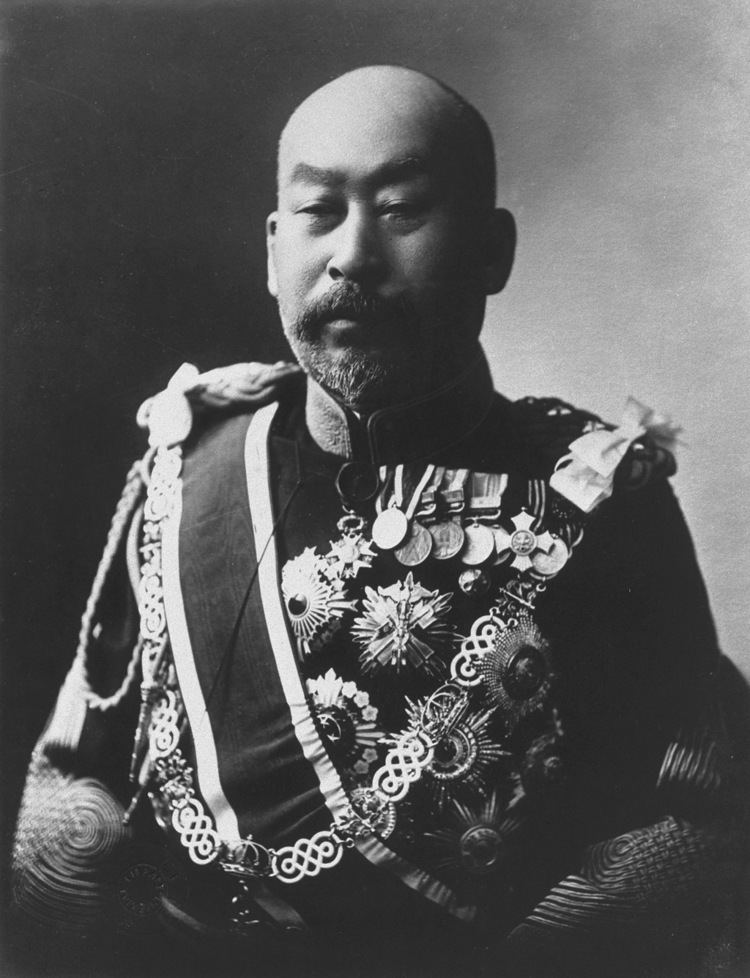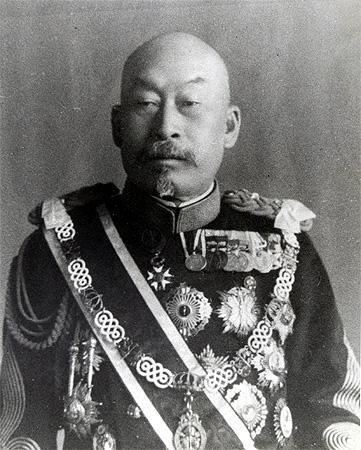Monarch Taisho Preceded by The Marquis Okuma | Monarch MeijiTaisho Name Terauchi Masatake Children Hisaichi Terauchi Preceded by Position established Role Politician | |
 | ||
Books Korea: Its History, Its People, and Its Commerce Similar People Hisaichi Terauchi, Hara Takashi, Kiyoura Keigo, Saigo Takamori, Aleksey Kuropatkin | ||
Political party Independent politician | ||
Gensui Count Terauchi Masatake (寺内 正毅), GCB (5 February 1852 – 3 November 1919), was a Japanese military officer, proconsul and politician. He was a Gensui (or Marshal) in the Imperial Japanese Army and the 9th Prime Minister of Japan from 9 October 1916 to 29 September 1918.
Contents
- Early period
- Military career
- Korean Resident General
- Political career
- Legacy
- Honours
- Popular culture
- References
Early period

Terauchi Masatake was born in Chōshū Domain (present-day Yamaguchi Prefecture) as the son of a samurai.

As a young soldier, he fought in the Boshin War against the Tokugawa shogunate, and later was commissioned second lieutenant in the fledging Imperial Japanese Army. He was injured and lost his right hand during the Satsuma Rebellion of 1877, but his physical disability did not prove to be an impediment to his future military and political career.
Military career

In 1882, after being sent to France for military study as military attaché, Terauchi was appointed to several important military posts. He was the first Inspector General of Military Education in 1898 and made that post one of the three most powerful in the Imperial Army. He was appointed as Minister of the Army in 1901, during the first Katsura administration. The Japanese victory in the Russo-Japanese War (1904–1905) occurred during his term as War Minister. After the war, he was ennobled with the title of danshaku (baron), and in 1911, his title was raised to that of hakushaku (count).
Korean Resident-General
General Viscount Terauchi (as he then was) was appointed as the third and last Japanese Resident-General of Korea on the assassination of Prince Itō in Harbin by An Jung-geun. As Resident-General, he executed the Japan–Korea Annexation Treaty in 1910, and thus became the first Japanese Governor-General of Korea.
The annexation of Korea by Japan and subsequent policies introduced by the new government was highly unpopular with large segments of the Korean population, and Terauchi employed military force to maintain control. General Terauchi used the deep historical and cultural ties between Korea and Japan as justification for the eventual goal of complete assimilation of Korea into the Japanese mainstream. To this end, thousands of schools were built across Korea. Although this contributed greatly to an increase in literacy and the educational standard, the curriculum was centered on Japanese language and history, with the intent of assimilation of the populace into loyal subjects of the Japanese Empire.
Other of Terauchi's policies also had noble goals but unforeseen consequences. For example, land reform was desperately needed in Korea. The Korean land ownership system was a complex system of absentee landlords, partial owner-tenants, and cultivators with traditional but without legal proof of ownership. Terauchi's new Land Survey Bureau conducted cadastral surveys that reestablished ownership by basis of written proof (deeds, titles, and similar documents). Ownership was denied to those who could not provide such written documentation (mostly lower class and partial owners, who had only traditional verbal "cultivator rights"). Although the plan succeeded in reforming land ownership/taxation structures, it added tremendously to the bitter and hostile environment of the time by enabling a huge amount of Korean land to be seized by the government and sold to Japanese developers. He was created a Count in the Kazoku in 1911.
Isabel Anderson, who visited Korea and met Count Terauchi in 1912, wrote as follows:
The Japanese Governor-General, Count Terauchi, is a very strong and able man, and under his administration many improvements have been made in Korea. This has not always been done without friction between the natives and their conquerors, it must be confessed, but the results are certainly astonishing. The government has been reorganized, courts have been established, the laws have been revised, trade conditions have been improved and commerce has increased. Agriculture has been encouraged by the opening of experiment stations, railroads have been constructed from the interior to the sea-coast, and harbours have been dredged and lighthouses erected. Japanese expenditures in Korea have amounted to twelve million dollars yearly.
Political career
In 1916, Count Terauchi became the 9th person to serve as Prime Minister of Japan. During the same year, he received his promotion to the largely ceremonial rank of Gensui (or Marshal). His cabinet consisted solely of career bureaucrats as he distrusted career civilian politicians. During part of his administration he simultaneously also held the post of Foreign Minister and Finance Minister.
During his tenure, Count Terauchi pursued an aggressive foreign policy. He oversaw the Nishihara Loans (made to support the Chinese warlord Duan Qirui in exchange for confirmation of Japanese claims to parts of Shandong Province and increased rights in Manchuria) and the Lansing–Ishii Agreement (recognizing Japan's special rights in China). Terauchi upheld Japan's obligations to the United Kingdom under the Anglo-Japanese Alliance in World War I, dispatching ships from the Imperial Japanese Navy to the South Pacific, Indian Ocean and Mediterranean, and seizing control of German colonies in Tsingtao and the Pacific Ocean. After the war, Japan joined the Allies in the Siberian Intervention (whereby Japan sent troops into Siberia in support of White Russian forces against the Bolshevik Red Army in the Russian Revolution).
In September 1918, Terauchi resigned his office, due to the rice riots that had spread throughout Japan due to postwar inflation; he died the following year.
His decorations included the Order of the Rising Sun (1st class) and Order of the Golden Kite (1st Class).
The billiken doll, which was a Kewpie-like fad toy invented in 1908 and was very popular in Japan, lent its name to the Terauchi administration, partly due to the doll’s uncanny resemblance to Count Terauchi's bald head.
Legacy
Terauchi's eldest son, Gensui Count Terauchi Hisaichi, was the commander of the Imperial Japanese Army's Southern Expeditionary Army Group during World War II. The 2nd Count Terauchi was also a Gensui (or Marshal) like his father.
Honours
From the corresponding article in the Japanese Wikipedia
